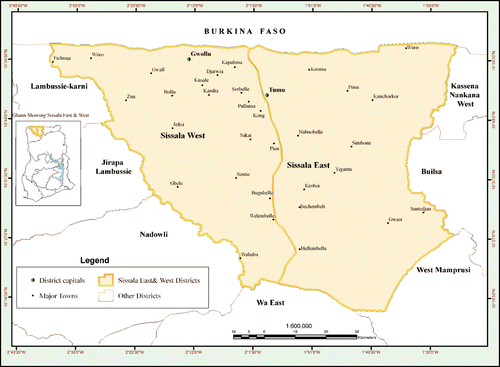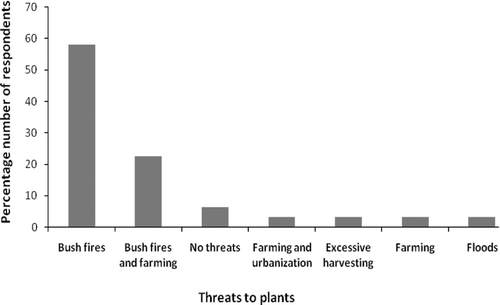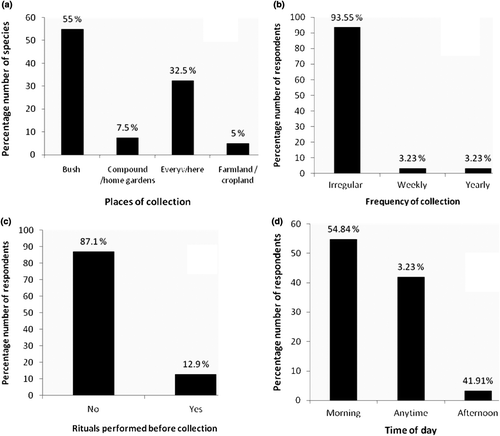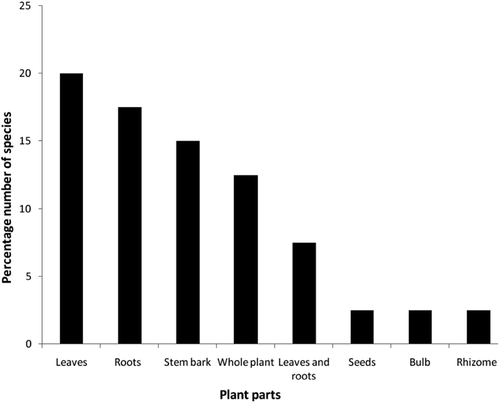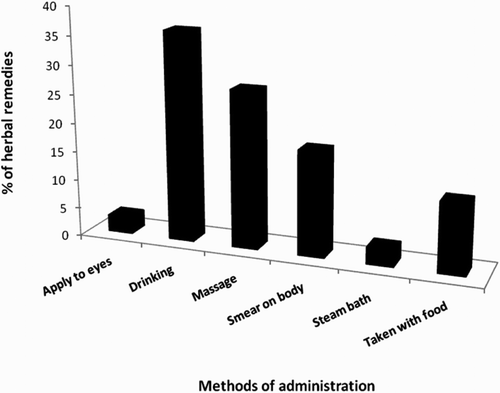Abstract
Context and objective: The Sisala traditional healers of northwest Ghana have a rich ethnomedical tradition. The purpose of this study was to collect and analyse data on medicinal plants commonly used by Sisala traditional healers.
Methods: A total of 30 traditional healers were interviewed using a mixture of open- and closed-ended questionnaires after obtaining prior-informed consent. Plant materials of each species of medicinal plant mentioned being used were collected and processed as voucher specimens following standard ethnobotanical methods.
Results: The majority (65%) of traditional healers were males, age ≥ 38, and their knowledge about medicinal plants was acquired orally largely from their parents (81.3%). A total of 35 species of plants were reported used to treat 24 diseases. Most (55%) of the plant materials were harvested from the bush and about half (54.8%) of the healers collected plant materials in the morning. Leaf (20%) and root (17.5%) plant materials were most commonly used in the preparation of 27 herbal remedies for treatments. The modes of administration of the herbal remedies were both through internal and external routes.
Conclusion: The results of this study show that Sisala traditional healers possess rich traditional knowledge about medicinal plants and new therapeutic use claims for 34 medicinal plants used in Ghana and widely within Africa are documented for the first time.
Introduction
Medicinal plants are of immense significance for the health care needs of people worldwide. It is currently estimated that about 70–80% of the world’s population rely chiefly on traditional, largely plant, medicine to meet their primary healthcare needs (CitationFarnsworth & Soejarto, 1991; CitationPei, 2001). A medicinal plant is any species of plant whose parts or whole plant contains active ingredients that can be used for therapeutic purposes or as a precursor for the synthesis of drugs. The efficacy of medicinal plants depends on the active chemical constituents and their pharmacological effects. About 35,000–70,000 species of plants are being used worldwide in health care systems (CitationFarnsworth & Soejarto, 1991). The global market of medicinal plant trade is estimated around US $60 billion per year and is growing at the rate of 7% annually with varying shares of developed and developing countries (CitationLaird & Pierce, 2002; CitationRaskin et al., 2002).
In Ghana and widely within Africa, medicinal plants have been reported used by many communities for the management of a wide range of diseases (CitationAsase et al., 2005, Citation2010; CitationAgyare et al., 2009; CitationShrestha & Dhillion, 2003; CitationTabuti, 2008; CitationTeklehaymanot et al., 2007). The use of medicinal plants for healing was the main method of treating various illnesses before the advent of orthodox medicine in Ghana (CitationAbbiw, 1990). The history of orthodox medicine in Ghana dates back to the colonization of the country by Britain in 1844 when British Medical officers were posted to the then Gold Coast to take care of the colonial administrators (CitationTwumasi, 2005). As time went on, the various missions in the country also brought in medical officers to take care of their personnel. Orthodox medicine is the official and widely recognized medical system in Ghana but it is heavily burden and poorly developed in terms of medical infrastructure and human recourses. There are relatively fewer hospitals and doctors; the doctor to population ratio is about 1:13,683 (CitationGhana Health Service, 2007). In contrast, there are many traditional healers and about 1360 species of medicinal plants are used.
Many tribes in Ghana, including the Sisala tribe, have elaborate traditional medicine knowledge and depend on the use of medicinal plants for their primary health care. The Sisala people are situated primary in northwest Ghana but include a small population in Burkina Faso. Some previous authors often referred to the Sisala and other politically acephalous people of northern Ghana and Burkina Faso as the “Grunshi” (CitationTamakloe, 1931). According to CitationGrindal (1972) the tribal designation Sisala is a product of recent evolution and is related to British colonial administration. Some cultural characteristics of this tribe are larger household size unit, compact settlement pattern, and preponderance of segmented communities (CitationGrindal, 1972). Detailed ethnographic data/classification of the Sisala people in northwest Ghana has been published (CitationMurdock, 1966, CitationGrindal, 1972). However, to the best of our knowledge there are no publications of studies on medicinal plants used by the Sisala people. Documentation of traditional knowledge about uses of medicinal plants is very important to modern society (CitationMoran et al., 2001) and might provide leads to drug discovery (CitationWHO, 2002). It is therefore hoped that the documentation of this component of cultural heritage of the Sisala people will be of benefit to both their present and future generations as well as to academics and health practitioners.
This study was conducted with the overall goal to collect and analyse data on medicinal plants commonly used by Sisala traditional healers living in northwest Ghana. Specifically, the objectives of the study were (1) to assess socioeconomic background of the healers and their associated traditional knowledge on medicinal plants; (2) to analyse the diversity of species and harvesting practices of medicinal plants commonly used; and (3) to document the methods of preparation and administration of herbal remedies used for treatment of their diseases. It also compared the traditional medicinal uses of the plants in this study within a larger African regional context.
Materials and methods
Study area
This study was conducted between April and November, 2010 in the Sisala East and West districts in the Upper West Region of Ghana (). The Sisala East district is located between longitude 13°W and latitudes 10.00°N and 11.00°N, and has a total land size of 4,744 km2. Sisala West district lies approximately between longitude 21.3° and 2.36°W, and latitude 10.00° and11.00°N covering a total land area of 4, 11289 km2. The vegetation in the study area is guinea savanna. Annual average temperature is within the ranges 23–42°C while rainfall is between 397 and 635 mm. The study area experiences a rainy season between April and October and dry season from November to March each year. The dry season is characterized by hot temperatures, strong harmattan winds, relative humidity could be as low as 20%. The major ethnic groups in the study area are Sisala and Dagaba although other minor tribes such as Walas can be found in the area. Farming of crops such as yams, millet, sorghum, rice, guinea corn and ground nuts is the main occupation of the people. Other income generating activities include charcoal and shea butter production as well as brewing of “pito” (a local fermented drink made from grounded millet) by women. Most of the indigenous Sisala people are either Muslims or traditional believers.
Data collection
Data were collected by interviewing traditional healers in the study area using a mixture of open- and closed-ended questionnaires. Before data collection, the chief locally called kuori and his elders in each community were first contacted, as local tradition demands, and the objectives of the study carefully explained to them. After acceptance of the concept of the project, the community leaders advised on healers that could be involved in the study based on the healers’ reputation in the treatment of human diseases. There could be possible biases associated with the selection of healers for interview based solely on the advice of community leaders. Consequently, a total of 30 healers from ten communities were randomly selected from the suggested list of healers provided by the community leaders. The selection was also influenced by the willingness of healers to participant in the study. Before interviewing healers verbal informed consent was obtained and customary gifts in the form of “kolas” were presented to them (see also CitationAgyare et al., 2009). In the study area traditional medicine is a specialist art practiced by specially-trained people and not many people are involved. The small sample size in this study is also a reflection of the fact that traditional healers are generally reluctant to share their knowledge with “outsiders”.
The interview sessions, which lasted an average of one hour, involved conversation with healers and collection of plant materials. During interviews, healers were asked specific questions about their socioeconomic characteristics, traditional knowledge of medicinal plants, species of medicinal plants used, diseases treated, and methods of preparation and application of herbal remedies for treatment as well as their medicinal plant harvesting practices. The interviews were conducted separately with each traditional healer in Sisala language (Sisali) by the lead author who is a native of the study area. Information gaps were amended through repeat visits and cross-checking (CitationCunningham, 2001; CitationAsase et al., 2010). Plant materials of the species of medicinal plants mentioned being used were collected with the healers and processed following standard methods (CitationMartin, 1995).
Results and discussion
Socioeconomic background of healers and medicinal plant knowledge
The socioeconomic characteristics of the traditional healers interviewed are presented in . The majority (64%) of the healers were males and this could be because traditional knowledge among the Sisala people is often passed from the male parent to his sons. Most (96.8%) of healers were ≥38 years and have extensive experience as about 90% of them have practiced for a period not less than 10 years. The result of this study is similar to that found in the Bulamogi county in Uganda where 85% of the healers were men aged 40 years or more (CitationTabuti et al., 2003). Women were also reported to have less traditional medicine knowledge than men around the Debre Libanos monastery in Ethiopia (CitationTeklehaymanot et al., 2007). In contrast, in some areas of the Amazon, knowledge and use of medicinal plants was found to be concentred among women because of their role as managers of household health (CitationWayland, 2001). Healers were predominately farmers (87.1%) and about 80.7% of them have no formal education although people from different socioeconomic backgrounds practiced healing.
Table 1. Socioeconomic characteristics of Sisala traditional healers.
The majority (81.3%) of the healers indicated that they acquired their knowledge about medicinal plants from parents. Others acquired this knowledge from relatives (6.3%) and friends (6.3%), and some while being treated with traditional medicine (3.1%). A few (3.1%) of them also obtained their knowledge through training under a senior practitioner. The mode of knowledge transmission was mainly through word-of-mouth. This system of knowledge acquisition and transfer appears to be very common in other parts of Ghana (CitationMshana et al., 2000) and widely elsewhere in Africa such as Uganda (CitationObbo, 1996), Gambia (CitationMadge, 1998), South Africa (CitationCocks & Dold, 2000) and Tanzania (CitationErdtseieck, 2000). Unlike biological traits largely transmitted by a vertical path through genes, cultural information can be transmitted through at least three distinct but not mutually exclusive paths, namely: (1) from parent-to-child (vertical transmission), (2) between any two individuals of the same generation (horizontal transmission), and (3) from non-parental individuals of the parental generation to members of the filial generation (oblique transmission) (CitationCavalli-Sforza & Feldman, 1981). The results of this study show that transmission of traditional knowledge about medicinal plants among the Sisala people is via all the above three pathways.
Diversity of species, local availability and harvesting practices
In total, 35 species of medicinal plants were reported commonly used for the treatment of 24 diseases by the healers ( and ). Most of the recorded species of plants belong to the Fabaceae (8 species), Combretaceae (3 species), Rubiaceae (2 species) and Malvaceae (2 species). Members of the above families have been widely reported for their medicinal uses in many African traditional pharmacopoeias (CitationAdjanohoun et al. 1993; CitationMshana et al., 2000) because they often contain active phytochemical constituents. The growth forms of the species of medicinal plants being used were shrubs (35%), trees (30%), herbs (30%) and climbers (5%) in decreasing order of number of species. The most commonly cited medicinal plants were Acanthospermum hispidum, Aparagus flagellaris, Vitellaria paradoxa, Parkia biglobossa, Piliostigma thonnigii and Khaya senegalensis. These species might therefore be of some cultural significance among the healers (CitationHeinrich et al., 2009). Many of the species of plants were mentioned by less three respondents, possibly indicating a more idiosyncratic knowledge for these plants among healers. Some of the species such as Waltheria indica and Terminalia macroptera were used for the treatment of more than one disease. In order to investigate whether the specific medicinal uses of species of plants reported in this study already been documented largely within Africa cross-referencing was made to standard literature (CitationAbbiw, 1990; CitationBurkill, 1985–2000Citation). Based on the literature survey, it was found that only the use of Zingiber offinale for tooth aches has been referenced (CitationAbbiw, 1990) although all the species have been previously documented for their therapeutic uses. This clearly follows that the present study has documented for the first time new therapeutic use claims for 34 medicinal plants that are used in Ghana and widely within Africa.
Table 2. Species of medicinal plants with single plant prescription.
Table 3. Species of medicinal plants with multiple plants prescription.
With regard to the local availability of medicinal plants being used, about 25.8% of the respondents indicated that medicinal plants were very abundant while 68% said that the plants were abundant. A few (16.5%) of the respondents mentioned that medicinal plants have become rare. Despite the fact that about 94% of the respondents said the plants used were either abundant or very abundant, the majority (94%) of them indicated that the availability of populations of the medicinal plants was being threatened by a number of factors such as bushfires, farming, urbanization and floods (). Similarly, in the Bosomtwi-Atwima-Kwanwoma area in Ghana, bushfires and farming were reported as having severe impacts on the availability of some of the plants used for management of wounds (CitationAgyare et al., 2009). It is very important to note that some (3.2%) of the respondents mentioned that species of plants were excessively harvested. The findings regarding harvesting practices as well as local availability and threats to the populations of the medicinal plants have implications for conservation. According to CitationHamilton (2004), because of the popularity of medicinal plants among communities they could be used as the basis for involving local people in the conservation of broader biodiversity.
Plant materials of the species used were mostly harvested from the bush () and the frequency of harvesting plant materials was irregular because majority (93.6%) of the respondents harvested plant materials as and when it was needed (). Most (87.1%) of the healers collected medicinal plants without performing any rituals (). However, a few of them performed some form of rituals before harvesting and the reason was to obtain permission from the “spirits”. The time of collection of medicinal plants can be an important issue because some plants have their full therapeutic potential when they are harvested at certain times (CitationAbebe, 1984, CitationPrance, 1994). Majority (54.8%) of the healers’ collected medicinal plants in the morning while very few (3.2%) of them harvested plants for uses in the afternoon because they said the ancestral or evil spirits would have driven the spirit of the plants away when the sun is hot. A larger proportion of the healers also harvested plants for use at anytime in the day as they indicated that people can get sick anytime of the day (). It was explained that they harvested medicinal plants in the morning because of ease of uprooting plant materials and also one would have not by then eaten which they said is a sign of good luck. None of the healers mentioned that plant materials were specifically harvested in the night. One of the healers indicated that he did not harvest medicinal plant materials on local market days since the spirits of the plants would have gone to the market.
Methods of preparation and administration of herbal remedies
For the preparation of herbal remedies, leaves (20%) and roots (17.5%) plant parts were commonly used () similar to report of previous authors (CitationAsase et al., 2010; CitationAbebe & Ayehu 1993; CitationGiday et al., 2003; CitationTeklehaymanot et al., 2007; CitationAsase et al., 2010). Plant materials were frequently used in the fresh state (61.3%) which means that the required amounts of plant materials were harvested and used as and when needed and this could mean no overharvesting. The reasons given for using plant materials in the fresh state was that they are more potent when used fresh and also they are juicy and can be easily grounded or made into poultice. About 35.5% of the plant materials were used in the dried state while 3.2% were used in both states. Dried plant materials were reported to be easy to char and/or pound into powder. The methods of preparation of herbal remedies were mostly decoctions (58.1%) as well as in the form of poultice (12.9%) and charcoal (29%). Animal products such as testicles of cock and the skins of particular species of snakes as well as local soap and salt (sodium chloride) were some of the ingredients added to the herbal preparations. Shea butter locally made from the seeds of Vitellaria paradoxa were frequently reported used. Both single and multiple plants component herbal remedies were reported; about 71.4% of the 21 herbal remedies were single plants prescriptions ( and 4). According to CitationSofowora (1993) traditional medicines prescribed may contain different components because some of the components are there as preservatives, others as flavouring agents, while others are colouring agents. It is also because in a single traditional remedy consisting of multi-component preparation the patient is treated for all his/her diseases. Traditional healers may also deliberately use many different plant species components in their treatment in order to mask the actual plant that is used as a remedy for the given ailment (CitationTeklehaymanot et al., 2007).
The routes of administration of the herbal remedies were through both external means such as massaging and smearing medicine on body as well as internal means such as drinking and taken medicines with foods (). Both external and internal routes of administration of traditional remedies are common in traditional and orthodox medicine practices. Most of the remedies were administered orally by drinking (36.4%) and massage (27.3%). Dosage prescriptions were largely unspecific, based on the experience of the practitioner, type of disease and adapted to the age of the patient. It was not surprising that about 97% of the respondents indicated that their herbal remedies had no side effects (CitationAsase et al., 2010).
Conclusions
This study has established that Sisala traditional healers possess rich knowledge about medicinal plants which is mostly acquired orally from their parents. The study has catalogued 35 species of medicinal plants commonly used by the healers and “new’’ therapeutic use claims for 34 of these medicinal plants are documented for the first time. It is important that pharmacological studies are initiated on these specific new therapeutic claims to verify their scientific basis in order to ensure that the patients who visit these healers get proper cure for their diseases. The findings of this study regarding local availability and threats, and harvesting practices of medicinal plants have implication for the conservation of wider plant diversity in the study area. Given the larger number of medicinal plants that are collected from the bush without any form of domestication being practised strategies should be developed for the protection of species frequently used. Ex situ conservation approaches such as home gardening and faming of the medicinal plants are recommended. This will support efforts in conservation of biodiversity and preservation of associated traditional knowledge.
It is important to note that the findings of this study are largely from the “specialist” perspective and might not represent general Sisala community knowledge unless corroborated by future reports. Therefore further studies should examine traditional knowledge and use of medicinal plants by the common people to allow for a better understanding of the role of herbal medicine in the health care of the Sisala people.
Acknowledgments
We are most grateful to the Sisala chiefs and people for their hospitality during fieldwork and permission to publish the data. We are thankful to Messrs Patrick K. Ekpe and John Y. Amponsah both of the Ghana Herbarium at the Department of Botany, University of Ghana for assistance with the identification of plants.
Declaration of interest
The authors declare no conflicts of interest.
References
- Abebe D, Ayehu A. (1993). Medicinal Plants and Enigmatic Health Practices of Northern Ethiopia. B. S. P. E: Addis Ababa, Ethiopia.
- Abebe W. (1984). Traditional pharmaceutical practice in Gondar region, northwestern Ethiopia. J Ethnopharmacol, 11, 33–47.
- Abbiw DK. (1990). Useful plants of Ghana. Intermediate Technology and Royal Botanic Gardens, Kew.
- Adjanohoun MRA, Ahyi L, Aké, Assi AM, Alia CA, Amai ZO, Gbile CLA, Johnson ZO, Kakooko HK, Lutakome O, Morakinyo NK, Mubiru JW, Ogwal-Okeng E.A., Sofowora A. (1993). Traditional medicine and pharmacopoeia: Contribution to ethnobotanical and floristic studies in Uganda. Scientific, Technical and Research Commission of the Organization eof the African Unity (OAU/STRC),
- Agyare C, Asase A, Lechtenberg M, Niehues M, Deters A, Hensel A. (2009). An ethnopharmacological survey and in vitro confirmation of ethnopharmacological use of medicinal plants used for wound healing in Bosomtwi-Atwima-Kwanwoma area, Ghana. J Ethnopharmacol, 125, 393–403.
- Asase A, Akwetey GA, Achel DG. (2010). Ethnopharmacological use of herbal remedies for the treatment of malaria in the Dangme West District of Ghana. J Ethnopharmacol, 129, 367–376.
- Asase A, Oteng-Yeboah AA, Odamtten GT, Simmonds MS. (2005). Ethnobotanical study of some Ghanaian anti-malarial plants. J Ethnopharmacol, 99, 273–279.
- Burkill HM. (1985–2000). The Useful Plants of West Africa. Vols. 1-5. Royal Botanic Gardens, Kew, Richmond.
- Cavalli-Sforza LL., Feldman M. (1981). Cultural Transmission and Evolution: A Quantitative Approach. Princeton University Press.
- Cocks M, Dold A. (2000). The role of ‘African chemists’ in the health care system of the Eastern Cape province of South Africa. Soc Sci Med, 51, 1505–1515.
- Cunningham AB. (2001). Applied Ethnobotany; People, Wild Plant Use and Conservation. Earthscan Publishers Limited, London.
- Erdtseieck J. (2000). Ethnography and the role of spirituality in African medicine and healing. In: Proceedings of the Conference Medicinal Plants, Traditional Medicines and Local Communities in Africa, Nairobi, 16–19 May, 2000.
- Farnsworth NR, Soejarto DD. (1991). Global importance of medicinal plants. In: Akerele O, Heywood V, Synge H. (eds.), The Conservation of Medicinal Plants. Cambridge University Press. Cambridge, UK, pp. 25–51.
- Ghana Health Service (2007). Annual Report of Ghana Health Service. 74 pp.
- Giday M, Asfaw Z, Elmqvist T, Woldu Z. (2003). An ethnobotanical study of medicinal plants used by the Zay people in Ethiopia. J Ethnopharmacol, 85, 43–52.
- Grindal BT.. (1972). An ethnographic classification of the Sisala of Northern Ghana. Ethnology, 4, 409–424.
- Hamilton AC. (2004). Medicinal plants, conservation and livelihoods. Biodiversity and Conservation, 13, 1477–1517.
- Heinrich M, Edwards S, Moerman DE, Leonti M. (2009). Ethnopharmacological field studies: A critical assessment of their conceptual basis and methods. J Ethnopharmacol, 124, 1–17.
- Laird SA, Pierce AR. (2002). Promoting Sustainable and Ethical Botanicals: Strategies to Improve Commercial Raw Material Sourcing. Rainforest Alliance, New York.
- Madge C. (1998). Therapeutic landscapes of the Jola, The Gambia, West Africa. Health Place, 4, 293–311.
- Martin G.. (1995). Ethnobotany: a methods manual. London: Chapman and Hall.
- Moran K, King SR, Carlson TJ. (2001). Biodiversity prospecting; lessons and prospects. Ann Rev Anthropol, 30, 505–526.
- Mshana RN, Abbiw DK, Addae-Mensah I, Adjanouhoun E, Ahyi MRA, Ekpere JA, Enow-Rock EG, Gbile ZO, Noamesi GK, Odei MA, Odunlami H, Oteng- Yeboah AA, Sarpong K, Sofowora A, Tackie AN.. (2000). Traditional Medicine and Pharmacopoeia: Contribution to the Revision of Ethnobotanical and Floristic Studies in Ghana. Institute for Scientific and Technological Information, Accra, 919 pp.
- Murdock GP. (1966). Ethnographic Atlas. Ethnology, 5, 317–346.
- Obbo C. (1996). Healing: Cultural fundamentalism and syncreticism in Buganda. Africa, 66, 183–201.
- Pei SJ.. (2001). Ethnobotanical approaches of traditional medicine studies some experiences from Asia. Pharmaceutical Biology, 39, 74–79.
- PORSPI, (1992). Ghana Herbal Pharmacopoeia. Policy Research and Strategic Planning Institute, Council for Scientific and Industrial Research, CSIR, Ghana.
- Prance GT. (1994). Introduction. In: Prance GT, Chadwick DJ, Marsh J. (Eds.), Ethnobotany and the Search for New Drugs. Ciba Foundation Symposium 185. John, Wiley and Sons, Chichester, England, pp. 57–90.
- Raskin I, Ribnicky DM, Komarnytsky S, Ilic N, Poulev A, Borisjuk N, Brinker A, Moreno DA, Ripoll C, Yakoby N, O’Neal JM, Cornwell T, Pastor I, Fridlender B. (2002). Plants and human health in the twenty-first century. Trends Biotechnol, 20, 522–531.
- Shrestha PM, Dhillion SS.. (2003). Traditional medicinal plant use and diversity in the highlands of Dolakha District Nepal. J. Ethnopharmaco, 86, 81–96.
- Sofowora A. (1993). Medicinal Plants and Traditional Medicine in Africa. 2nd Edition. Spectrum Books Ltd. 289 pp.
- Tabuti JR, Dhillion SS, Lye KA. (2003). Traditional medicine in Bulamogi county, Uganda: Its practitioners, users and viability. J Ethnopharmacol, 85, 119–129.
- Tabuti JR. (2008). Herbal medicines used in the treatment of malaria in Budiope county, Uganda. J Ethnopharmacol, 116, 33–42.
- Tamakloe EF. (1931). A Brief History of The Dagomba People. Accra: Government Printer.
- Teklehaymanot T, Giday M, Medhin G, Mekonnen Y. (2007). Knowledge and use of medicinal plants by people around Debre Libanos monastery in Ethiopia. J Ethnopharmacol, 111, 271–283.
- Twumasi PA. (2005). Medical Systems in Ghana- A Study in Medical Sociology. Ghana Publishing Corporation. 178 pp.
- Wayland C. (2001). Gendering local knowledge: medicinal plant use and primary health care in the Amazon. Med Anthropol Q, 15, 171–188.
- WHO. (2002). Traditional Medicine Strategy 2002–2005. World Health Organization, WHO/EDM/TRM/2002.1, Geneva.
